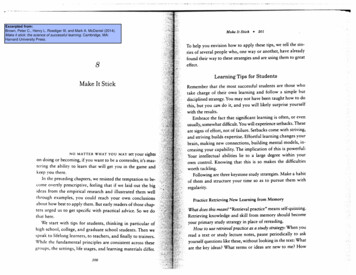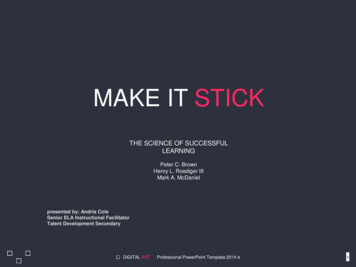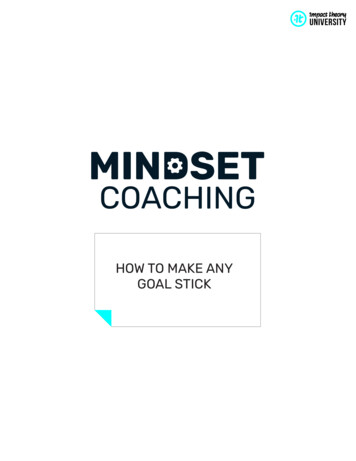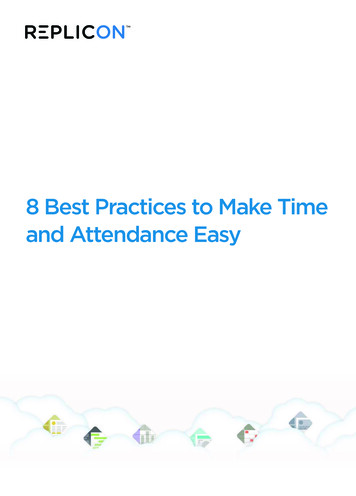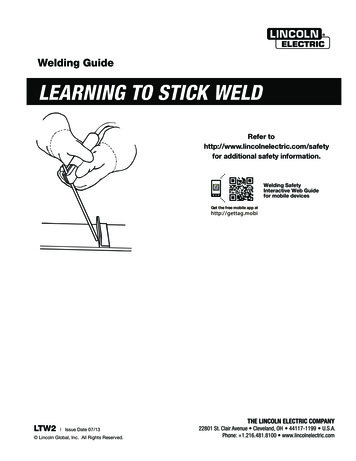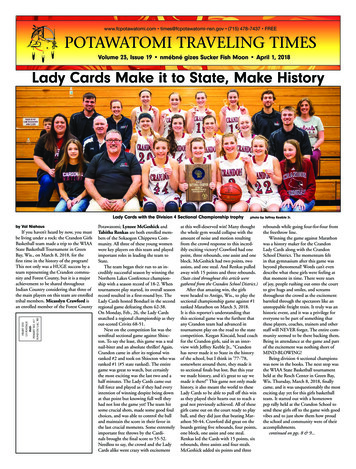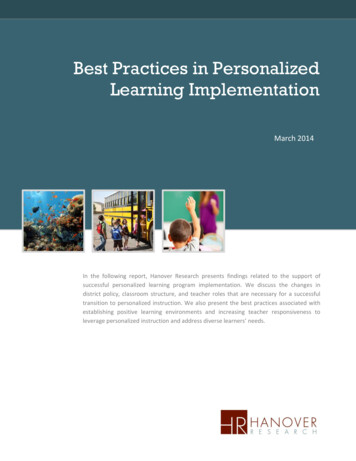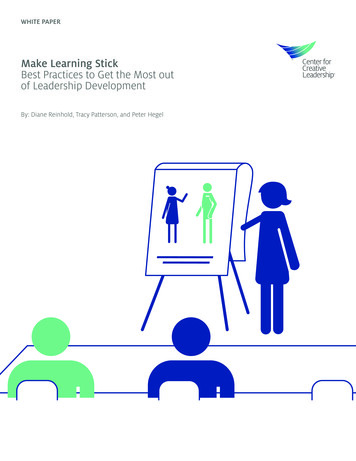
Transcription
WHITE PAPERMake Learning StickBest Practices to Get the Most outof Leadership DevelopmentBy: Diane Reinhold, Tracy Patterson, and Peter Hegel
“Tell me and I forget, teach me and I mayremember, involve me and I learn.”—Chinese Confucian philosopher Xunzi (312-230 BC)ContentsIntroduction1Learning Transfer: 3 x 3 x 33Think in 3 Phases5Use 3 Strategies (or More)6Engage 3 Partners10Linking Learning to Business Success13Take Action14Conclusion15Refererences16About the Authors17
IntroductionAre you taking a closer look at “learning transfer”? Are you wondering how to make sure the lessonstaught through your leadership training and development efforts stick weeks, months, or years later?There is no magic bullet to ensure people apply what they learn. But there are steps you can take tocreate leadership programs, experiences, and supports that improve the likelihood that lessons willbe learned and applied. Over time, new skills, perspectives, or behaviors can be reinforced, until theybecome unconsciously and competently put to use.We understand that individuals—and organizations—face significant challenges in their efforts toapply and integrate learning and develop the leadership capacity they need. These include:Challenge: Formal training is just one aspectof learning. Workshops, classes, and leadershipinitiatives do not guarantee that ideas, practices,or solutions are understood well enough to be putto use. After a program, new learning is fragile.It easily slips away without application, practice,and support.Challenge: Leadership—and its development—is always dependent on the people involvedand the context. Leadership development isabout learning and applying “soft skills”—skillsthat require the ability to adapt ideas andguidelines to their environment. These skillsrequire discernment, judgment, and presenceof mind—in addition to the willingness andmotivation to practice that is required to learnany new skill. In contrast, “hard skills” are moredirectly replicable in the training environment—which is why computer training or technical skillsare easier to simulate during training (Laker &Powell, 2011).Challenge: Leaders are already overloaded.Even with clear goals and the best of intentions,leaders often falter because of the pressureand pace of work. After a few days away tolearn and reflect, participants typically returnto a dynamic, high-pressure work environmentwith many issues competing for their attention(Blume, Ford, Baldwin, & Huang, 2010). In suchan environment, leaders feel they don’t havetime to pause and consider what they could dodifferently, despite their best intentions.Challenge: Learning isn’t always alignedwith what matters most. Excellent andinteresting leadership lessons and insights mayor may not seem relevant to the learner’s realworld challenges. Without alignment betweenthe learner’s challenges, the organization’spriorities, and the leadership development, theopportunities to practice what was learned orto try something new will be limited—or quicklydismissed.Challenge: The learning culture clashes withthe operational culture. Participants in CCL’sleadership development have identified learningtransfer barriers such as lack of team support,leadership, and organizational culture. Manyaspects of an organization’s culture, policies, andsystems can frustrate leaders when they try toapply what they have learned (Leone, Marino,& Richards, 2006). For example, incentives orproject metrics may fail to encourage desiredbehaviors, or senior management may not begood role models for stated cultural or leadershipexpectations. 2015 Center for Creative Leadership. All rights reserved.1
As a professional interested in learning and development, you may be in aposition to acknowledge and help overcome the challenges to learning in yourorganizations. You are likely in a position to influence supervisors and executives,as well as potential participants, in leadership development efforts. You may alsohave a role in creating and supporting a learning environment. With a betterunderstanding of learning transfer, you can help your organization realize multiplebenefits, including bigger impact from developmental experiences, more effectiveleaders, and a stronger organizational ability to learn and adapt.Read on to learn CCL’s perspective on and best practices for learning transfer forleadership development. We share a framework—and specific tactics—that weuse in designing leadership development solutions. With this information, youcan begin to help leaders and your organization overcome challenges to learningtransfer—and earn greater benefit from leadership development investments.2 2015 Center for Creative Leadership. All rights reserved.
Learning Transfer: The 3 x 3 x 3 Model Learning is a process, and works best whenit is viewed as more than merely a program.Leadership development can include formalor classroom-based training—but it is just onepiece of the learning puzzle that must havecorresponding pieces back on the job.Research supports the value of extendinglearning into the workplace and connectingthe workplace into formal learning. Mostexecutives cite on-the-job experiences as thekey events that shaped them as leaders andtaught them important skills, behaviors, ormindsets. In fact, research shows that seniorexecutives distribute their sources of keydevelopmental experiences as 70% on-thejob challenges, 20% other people, and 10%formal coursework and training (Lombardo& Echinger, 1996; Wilson, Van Velsor,Chandrasekar, & Criswell, 2014). We use 70-2010 as a guideline, not a formula for creatinglearning experiences. Yet, we know thatexperiences that focus on creating learning inall three categories can boost learning transferand accelerate development.Learning transfer is also a social process.Learning—and the desired performance thatcomes from learning—does not take place inisolation. The work context, including the levelof support from role models, mentors, peers,coaches, and bosses, has a powerful impacton turning lessons learned into leadership inaction (Blume, Ford, Baldwin, & Huang, 2010).Drawing on our understanding of andexperience with adult learners, we’ve createda “3 x 3 x 3 Model for Learning Transfer.”This framework informs our leadershipdevelopment work—and can be applied todevelopment programs or initiatives withinyour organization.Think in 3 PhasesUse 3 Strategies (or More)Involve 3 PartnersPrepareKey Leadership ChallengeThe LearnerEngageIn-Class Accountability PartnersThe OrganizationApplyAt-Work Learning PartnersThe Training PartnerThis 3 x 3 x 3 matrix incorporates many of the best practices cited in the research on learningtransfer. The middle column in our matrix—strategies—focuses on the three minimum strategiesthat CCL usually includes in the design of leadership development initiatives. There are otherstrategies we’ll address in this paper as well, including another CCL hallmark: coaching.It is important to remember that learners—and organizations—have different needs. You’ll wantto provide a variety of options to help people apply and deepen their learning. Experiment withwhat works in your organization. 2015 Center for Creative Leadership. All rights reserved.3
3 x 3 x 3 MODEL to drive learning transfer and support participantsLearning is a process, not a program. It should start from the moment participantsregister until they’re unconsciously and competently using their new learnings in their lives.Think in3 Phasesbeyond the classroomUse3 Strategiesthe minimum to build into each program3Ensure Partners TakeResponsibilityeveryone has to take it onP REPAREKEY LEADERSHIPCHALLENGEHow might youget participantsapplying content toa leadership challengein prepare, engage,and apply phases?Assessments and .?How might you help participantsengage in the development processas soon as they register?Active,not passive.They must own theirlearning and use it.How might theydemonstrate that?PARTICIPANTPaying the billisn’t enough.Don’t just teach.How mightyou createopportunitiesfor guidedpractice andskill development?YLASS BILITIN-C OUNTAACC TNERSPARCreate (in “prepare” if possible) andleverage the bonds that form in theengage phase so they can supporteach other as they “apply” what theylearned. How might you create aformal structure for this?E NGAGEWhat might theorganization do to supportparticipants andensureopportunitiesto apply?CLIENTORGANIZATIONLearning, not just training.A PPLYAT-WORKLEARNINGPARTNERSProvide support at work.How might you createopportunities for theparticipants to use andcontinue newlearning atwork (andbeyond)?Whether it’s their boss, mentor,internal coaches,HR, business partner,or someone else they trust, how mightwe foster meaningful developmentthrough all phases of the program?www.ccl.org 2016 Center for Creative Leadership. All rights reserved. CVD:1112016P4 2015 Center for Creative Leadership. All rights reserved.What mightCCL do to maximize thelikelihood of transferof learning (faculty,client services, coaches,program support,learning products, etc.)?CCL
ApplyThink in 3 PhasesWhat happens before and afterthe formal part of a programor development effort is just asimportant as the content anddelivery. This is true whether theinitiative is long or short, in-personor virtual, ongoing or one-time. CCLtakes the “Prepare, Engage, Apply”approach to helping individuals andorganizations get the most out ofleadership development.LearningJourneyEngagePreparePrepare. As soon as a person is tapped for or haschosen to participate in a formal leadership effort,the development process begins. How might you helpparticipants start learning right away? How do youget them thinking about their leadership experiences,challenges, and needs? How do you help themconnect to the purpose, content, and value of theirdevelopment experience?Engage. The content of a learning experience isimportant, but so is the way it is presented. Listeningto speakers and reading information is a passivelearning process—and information is less likely tostick than processes that connect and engage eachperson through applied practice. How might youcreate opportunities for guided practice and skilldevelopment throughout the program?The prepare phase involves good communicationabout logistics and expectations—but also beginsto build an emotional connection to personalize thelearning experience. It is a chance to engage andexcite the learner—rather than approaching theprocess as another item on their calendar (Stewart,Palmer, Wilkin, & Kerrin, 2008). Research showsthat participants begin to engage in a developmentexperience when they are able to make plans witha boss, mentor, or coach and discuss the supportthey will need (Brown & McCracken, 2010; Lancaster,Milia, & Cameron, 2013). In addition, learners needinformation and activities to help them understandhow the program will benefit them (Katzell &Thompson, 1990).Whether you are working in a live, face-to-face settingor a virtual classroom, consider a mix of activitiessuch as skill-building, action-learning, reflection,simulations, experiential activities, goal-setting, andcoaching.CCL prepares learners for their experienceby providing guidelines for interviewing keystakeholders, selecting challenges to apply courselearning, providing brief e-learning segments, andasking the learners and their colleagues to completeassessments of their leadership skills and style. Otheractivities could include reading assignments, videosfrom past participants describing their experience, orwelcome videos or webinars from the faculty.Apply. Reinforcement and support at work—awayfrom the learning environment and over time—isessential for learning transfer. How might you createopportunities for the participants to use and continuenew learning at work and beyond?Most people need structures that foster theapplication of new concepts and practice of new skillsto achieve behavior change. Participants need supportand encouragement to get past the initial awkwardphase that accompanies the application of new skills.Some options include action-learning projects tied toreal work issues, conversations to help connect newlearning to an existing business challenge, followup lessons through reading, discussion, eLearningassignments, toolkits or job aids, and coachingfocused on making progress on goals. 2015 Center for Creative Leadership. All rights reserved.5
Use 3 Strategies (or More)CCL designs at least three learning transfer strategies into leadership development: Key LeadershipChallenge, In-Class Accountability Partners, and At-Work Learning Partners.Key Leadership Challenge. A Key LeadershipChallenge is an existing project that aligns with theorganization’s strategy and requires new approachesto be successful. This challenge enhances learning byproviding a direct link from the workplace to what isbeing taught in the development process. This ensuresthat the learner, the manager, and the organization allsee this leadership development work as important tothe organization as well as the leader. It also providesopportunities for learners to practice new skills andencourages them to identify specific ways that theywill apply new behaviors and processes.In-Class Accountability Partners. A transformativedevelopmental experience will connect peers wholearn together, share experiences, and discusschallenges and goals. This tends to create a bondbetween participants that creates an interest inhelping each other succeed. Development processesthat tap into these ties build accountability, ensuringthat the best intentions of participants at a moment intime continue into the future. In-Class AccountabilityPartners become sounding boards as they strugglethrough similar challenges. They can encourage,support, and push each other.At CCL, we ask learners to select a Key LeadershipChallenge before engaging in development. Examplesinclude:Ways to use In-Class Accountability Partnerseffectively as part of l
stick than processes that connect and engage each person through applied practice. How might you create opportunities for guided practice and skill development throughout the program? Whether you are working in a live, face-to-face setting or a virtual classroom, consider a mix of activities such as skill-building, action-learning, reflection,
